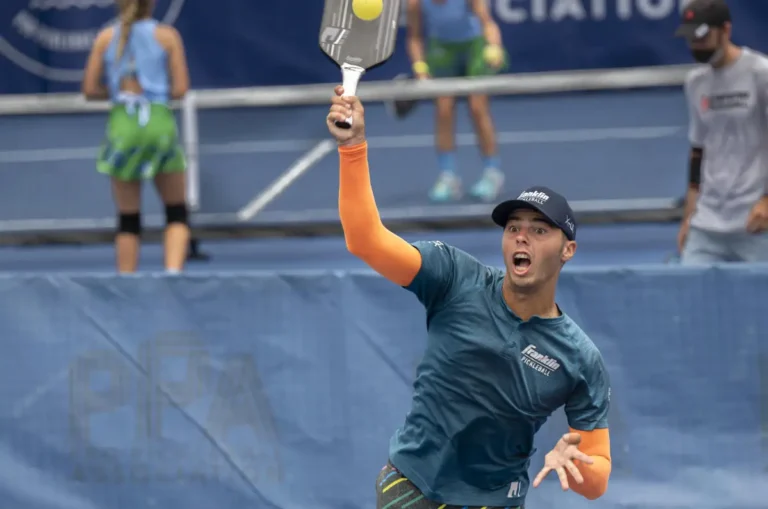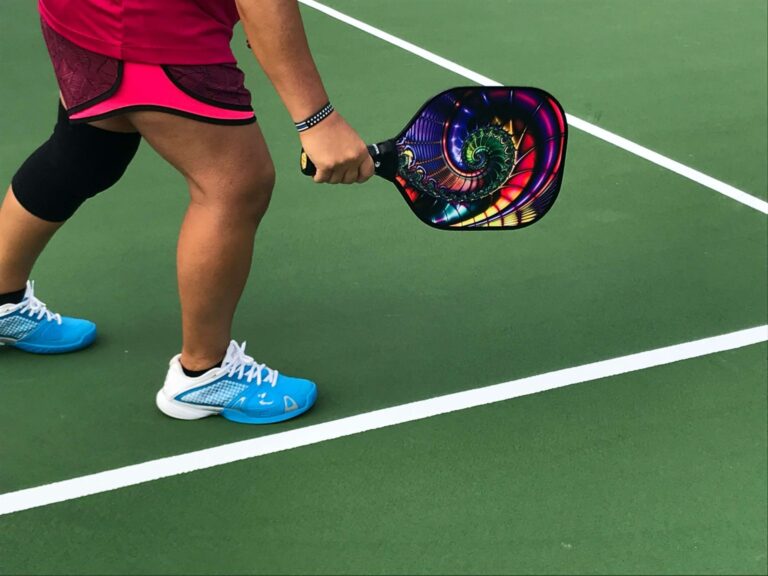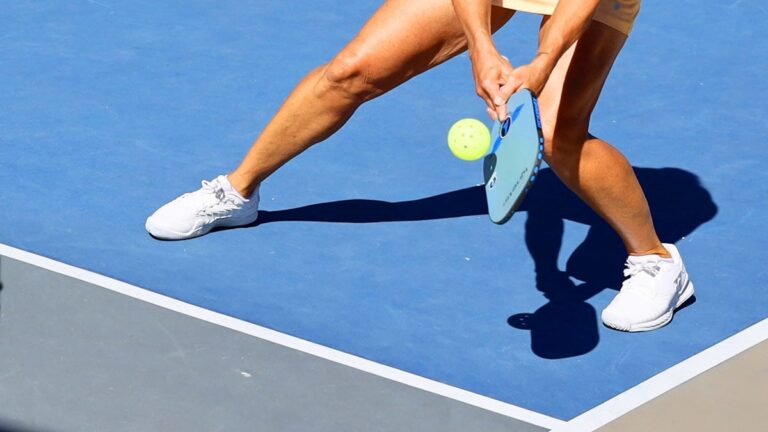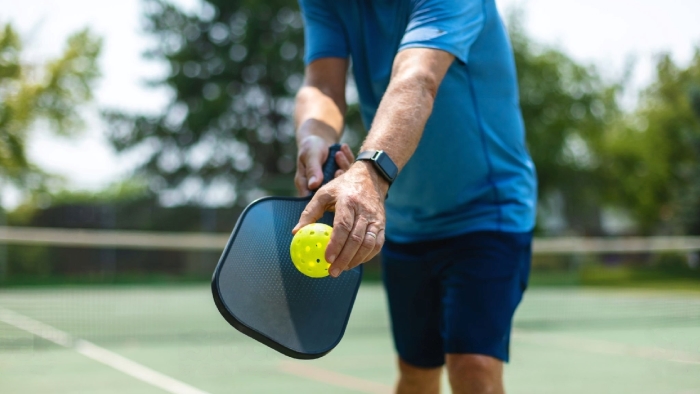What is a Rally in Pickleball? A Comprehensive Guide for Players and Enthusiasts
Hey there, pickleball enthusiasts and curious minds! If you’ve found yourself captivated by the fast-paced, exciting world of pickleball, you might be wondering, “What exactly is a rally, and why is it such a big deal?” Well, buckle up because we’re about to dive deep into the heart of pickleball gameplay and unravel the mysteries of the rally.
What is Pickleball?
Before we get into the nitty-gritty of rallies, let’s make sure we’re all on the same page about pickleball itself. In a nutshell, pickleball is a paddle sport that borrows elements from badminton, tennis, and table tennis. It’s played on a smaller court than tennis, with a slightly modified tennis net, and uses a perforated plastic ball and solid paddles. The game has been around since the 1960s but has recently exploded in popularity, attracting players of all ages and skill levels.
The Core Gameplay
Now that you know what pickleball is let’s talk about how it’s played. The basic structure of a pickleball game involves serving, returning the serve, and volleying. Here’s a quick breakdown:
- Serving: The game starts with an underhand serve, diagonally across the court, and must clear the non-volley zone (aka the “kitchen”).
- Returning the Serve: The receiving team must let the ball bounce once before returning the serve.
- Volleying: After the serve and return, players can volley the ball back and forth until a fault occurs.
Simple enough, right? But what happens during that volleying phase? That’s where the real magic of pickleball takes place, and it’s all thanks to the rally.
Understanding the Rally

The Heart of the Action
A rally is the continuous back-and-forth play between teams after the initial serve and before a fault occurs. It’s the meat and potatoes of pickleball, where players showcase their skills, strategize, and engage in thrilling exchanges. Rallies can last anywhere from a few seconds to several minutes, depending on the players’ abilities and the intensity of the game.
Keys to a Good Rally
To keep a rally going, players must master a few key aspects of the game:
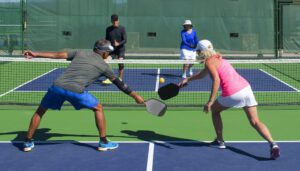
- Volleys: Volleys are shots hit before the ball bounces on your side of the court. They require quick reflexes and good hand-eye coordination.
- Groundstrokes: Groundstrokes are shots hit after the ball has bounced on your side of the court. They provide more time to react but require proper footwork and positioning.
- Dinking: Dinking is a soft shot hit close to the net, designed to force your opponent to hit up on the ball, giving you an opportunity to attack.
Mastering these shots and knowing when to use them is crucial to maintaining a good rally and ultimately winning the point.
Ending the Rally
As much as we’d love for rallies to go on forever, they eventually come to an end. A rally can end in a few ways:
- Hitting the ball out of bounds
- Failing to return the ball over the net
- Double faulting (hitting the ball into the net or out of bounds on a serve)
- Volleying the ball from the non-volley zone (the “kitchen”)
When a rally ends, the point is awarded to the team that didn’t commit the fault.
The Anatomy of a Pickleball Rally
Now that we’ve covered the basics let’s break down the different parts of a pickleball rally.
The Serve and Return of Serve
The serve is the first shot of the rally and sets the tone for the rest of the point. A good serve should be deep, aggressive, and aimed at your opponent’s weaknesses. The return of serve is equally important, as it determines whether you’ll be playing offense or defense for the rest of the rally.
| Serve | Return of Serve |
|---|---|
| – Underhand motion | – Must let the ball bounce once |
| – Diagonally across the court | – Aim for depth and placement |
| – Must clear the non-volley zone | – Determine offensive or defensive position |
| – Sets the tone for the rally | – Crucial for establishing control |
Keeping the Ball in Play
Once the serve and return are out of the way, the real work begins. To keep the rally going, players must continuously hit the ball back and forth over the net until a fault occurs. This requires a combination of skill, stamina, and mental toughness.
Scoring Points During a Rally
In pickleball, points can only be scored by the serving team (in traditional scoring) or by either team (in rally scoring). We’ll dive into the differences between these two scoring systems later on.
Common Strategies Used During Rallies
To win rallies and ultimately the game, players employ various strategies, such as:
- Attacking the middle: Hitting the ball between your opponents can cause confusion and force a weak return.
- Utilizing the dink shot: Dinking keeps the ball low and forces your opponents to hit up, giving you an opportunity to attack.
- Playing to your strengths: If you have a strong forehand, aim your shots to your opponent’s backhand to take advantage of your skills.
Types of Rallies in Pickleball
Not all rallies are created equal. Depending on the players’ styles and the game’s flow, you might encounter different types of rallies.
Short Rallies
Short rallies are quick exchanges that last only a few shots. They often result from a powerful serve or a well-placed attack that catches the opponent off guard. While short rallies can be exciting, they don’t always showcase the full range of a player’s skills.
Long Rallies
Long rallies, on the other hand, can last several minutes and involve dozens of shots. These rallies are a true test of endurance, skill, and mental fortitude. They often feature extended dinking exchanges, with players waiting for the perfect opportunity to attack.
Offensive Rallies
Offensive rallies are characterized by aggressive shots and a focus on ending the point quickly. Players who excel at offensive rallies have powerful serves, strong groundstrokes, and a knack for finding open court space.
Defensive Rallies
Defensive rallies, as the name suggests, involve a more cautious approach. Players engage in longer exchanges, focusing on consistency and waiting for their opponent to make a mistake. Defensive rallies often feature more lobs, dinks, and soft shots designed to keep the ball in play.
Types of Scoring and Rallies
Pickleball has two main scoring systems, each of which impacts the way rallies play out.
Traditional Scoring
In traditional scoring, points can only be scored by the serving team. If the serving team wins the rally, they score a point and continue serving. If the receiving team wins the rally, they don’t score a point but instead gain the right to serve. Games played with traditional scoring typically go to 11 points, and teams must win by 2.
Rally Scoring (The Modern Way)
Rally scoring, on the other hand, awards a point to the team that wins the rally, regardless of who served. This system has gained popularity in recent years because it leads to faster gameplay and more opportunities for scoring. In rally scoring, games are typically played to 15 or 21 points, and teams must still win by 2.
The introduction of rally scoring has had a significant impact on the way pickleball is played. With the potential to score on every rally, players are more aggressive and take more risks. This has led to shorter rallies overall but also more exciting and dynamic gameplay.
| Scoring System | Points Awarded | Typical Winning Score | Impact on Rallies |
|---|---|---|---|
| Traditional | Only the serving team can score | 11 points | Longer rallies, more strategic play |
| Rally | The team that wins the rally scores a point | 15 or 21 points | Shorter rallies, more aggressive and risky play |
Tips for Improving Your Pickleball Rallies
Want to take your pickleball rallies to the next level? Here are some tips to help you improve:
- Practice consistently: The more you play, the more comfortable you’ll become with the rhythm and flow of rallies. Make sure to practice all aspects of your game, from serves and returns to volleys and groundstrokes.
- Focus on footwork and positioning: Good footwork is key to being in the right place at the right time during a rally. Practice moving efficiently around the court, and always be ready to adjust your position based on your opponent’s shots.
- Communicate effectively with your partner: If you’re playing doubles, communication is crucial. Make sure you and your partner are on the same page about who’s taking which shots and where you’re positioning yourselves on the court.
- Vary your shots: Don’t become too predictable during rallies. Mix up your shots, using a combination of dinks, lobs, and powerful drives to keep your opponents guessing.
Frequently Asked Questions about Pickleball Rallies
What is the average length of a pickleball rally?
The length of a pickleball rally can vary greatly depending on the skill level of the players and the style of play. On average, rallies last between 4-8 shots, but some rallies can extend to 20 shots or more.
How can I win more rallies in pickleball?
To win more rallies, focus on consistency, placement, and patience. Keep the ball in play, aim for your opponents’ weaknesses, and wait for the right opportunity to attack. Don’t forget to mix up your shots and communicate effectively with your partner in doubles play.
What is the difference between a rally and a volley in pickleball?
A rally refers to the entire exchange of shots between teams, from the serve to the point-ending fault. A volley, on the other hand, is a specific type of shot hit before the ball bounces on your side of the court.
How do I practice pickleball rallies on my own?
To practice rallies on your own, you can use a ball machine or a practice partner. Focus on consistency and accuracy, aiming to keep the ball in play for as long as possible. You can also work on specific shots, like dinks and lobs, to improve your overall rally skills.
What are some strategies for winning a rally?
Some effective strategies for winning rallies include:
- Attacking the middle of the court
- Using the dink shot to force your opponent to hit up
- Playing to your strengths
- Identifying and exploiting your opponents’ weaknesses
- Adjusting your strategy based on the game’s flow
How can I improve my volleying skills for better rallies?
To improve your volleying skills:
- Practice hitting volleys from various positions on the court
- Focus on keeping your paddle face steady
- Use a short, compact swing
- Work on your reaction time by having a partner hit balls at you from close range
What are some exciting rally moments to watch in professional pickleball?
Professional pickleball is full of exciting rally moments. Some notable examples include:
- Long, fast-paced exchanges between top players like Ben Johns and Tyson McGuffin
- Incredible diving saves and acrobatic shots from players like Simone Jardim and Lucy Kovalova
- Strategic dinking battles that showcase the finesse and control of elite players
Watching professional pickleball can give you a deeper appreciation for the sport and inspire you to improve your own rally skills.
Conclusion
Rallies are the backbone of pickleball, providing the sport with its signature excitement and challenges. By understanding the different aspects of rallies, from serving and returning to volleying and dinking, you can elevate your own game and become a more well-rounded player.
Remember, pickleball is a sport that rewards consistency, strategy, and adaptability. The more you practice and play, the more comfortable you’ll become with the flow of rallies and the nuances of the game.
So what are you waiting for? Grab your paddle, head to the court, and start rallying! Whether you’re a seasoned pro or a curious beginner, pickleball has something to offer everyone. And who knows? With a little practice and dedication, you might just find yourself in the middle of an epic rally, experiencing the thrill of the game firsthand.
Happy playing, and may your rallies be long, exciting, and full of pickleball joy!

